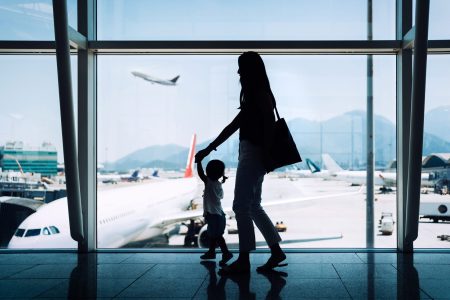More than five years ago, remote work was almost unheard of. I used to go into an office, sit in a cubicle and do the same work I do now, albeit with more chit-chat at the espresso machine. Now, I only have my dog to gossip with.
Among employees whose work can be done from home — not including professions like mechanics, pilots and nurses, to name a few — I’m one of the roughly 1 in 3 (32 percent) who work fully from home since the pandemic.
Pew Research Center reports another 2 in 5 (43 percent) work from home some of the time, like with a hybrid schedule, and 1 in 4 (25 percent) rarely or never work from home. That’s largely because employers have started calling employees back into the office for a certain number of days.
But for remote workers, the digital nomad life is appealing. A world of travel opens up when you’re not tied to an office. I’ve worked from Mexico, Hawaii and all across the Southwestern United States.
James Royal, principal writer at Bankrate, also works remotely and recently relocated to Geneva, Switzerland, for his wife’s new job.
“It’s just my wife and I, since we have no kids — which makes the decision so much simpler to make,” he says. “We made the decision fairly quickly, without significant reservations.”
For some, though, the cost might be an obstacle. After all, Bankrate’s 2025 Summer Travel Survey shows that more than half of Americans aren’t traveling this summer (54 percent), and nearly 2 in 3 of the non-travelers (65 percent) say it’s because they can’t afford to.
I’m sharing some of my own and Royal’s money-saving steps below to help you travel frugally while working remotely.
You really do start with no resources when you hit the ground in a foreign place, and you’ll need to establish that social capital to thrive in your new home.
— James Royal
Principal Writer, Bankrate
6 tips for working remotely and traveling
Whether you’re heading to Thailand or Texas, here’s how to work from another location while sticking to a budget.
1. Get your paperwork in order
If you’re traveling to a foreign country, you’ll need to look into its visa requirements. Many countries let you stay fewer than three months without a visa. But if you plan to stay longer, you can apply for a digital nomad visa or another type of tourist visa offered by the country.
“Expats will need to do that legwork themselves, navigating the system without always the clearest idea of how to do so,” Royal explains. “You’ll need to run down to the local government offices with the right paperwork.”
You also want to consider both travel and health insurance. Credit card travel insurance can protect you from things like trip interruptions, lost baggage and rental car collisions. But read the fine print carefully, as there may be limits to the length of your trip. There are other types of travel insurance tailored to long-term digital nomads.
In addition, confirm that your travel insurance policy covers healthcare emergencies, because U.S. health insurance typically doesn’t cover you outside the country.
If you’re staying within the country, the paperwork is simpler. But you may be required to inform your employer of long-term remote work for tax purposes and labor laws.
Not having the right documentation could end up being a costly mistake.
2. Calculate housing costs
Accommodations are one of the most expensive parts of being a digital nomad, so it’s common to forego any long-term rent you’re currently paying in exchange for short- or mid-term rentals. If you own a home, you can look into renting it out to cover your mortgage.
In preparing for your next destination, look at websites like Airbnb or Furnished Finders for mid-term rentals or even hostels for short-term stays.
I spent two months working from Sayulita, Mexico, a few years ago, where I rented a lovely Airbnb for just $500 a month. And I timed it to follow the end of a lease, so I wasn’t paying double for housing in both countries.
But make sure your accommodation has a strong Wi-Fi connection or plan to work at a co-working space for more stability.
The first time I tried to join a Zoom call from my Sayulita home, my Wi-Fi connection failed. I had to scramble to find a co-working space — an added cost to my budget — for the rest of the summer. In hindsight, I would’ve refined my accommodation search based on reviews about the connectivity from other remote workers.
3. Book affordable travel
Whether you’re getting to your next destination by plane, train or car, there are travel costs to consider.
If you’re flying, try planning your travel dates during non-peak seasons, days and times. Digital nomads tend to have more flexibility, so you can opt for a Tuesday instead of a Sunday flight if it knocks down the price. Avoid flying during holiday breaks or prime tourist season, if possible. A flight tracker can also be helpful if you have time to monitor prices before your trip.
If you’re driving, you can plan your stops to accommodate your work schedule. I work on the road pretty regularly by finding coffee shops or comfortable picnic areas along my route, using free Wi-Fi or my hotspot. After-work hours and weekends are reserved for driving and exploring. You can also time your gas stops for bigger towns — where gas is cheaper — and use a wholesale club card for even better prices, when possible.
4. Live like a local
A general rule of thumb for affordable travel is, when in Rome, do as the Romans do.
That might include grocery shopping and cooking at home, taking public transportation and enjoying free local entertainment. Royal says that, while the cost of living is higher in Geneva, he and his wife save money in other ways.
“We live right in the middle of the city and so we have no need for a car, eliminating one of the most expensive items entirely,” he explains. They don’t pay for gas, car insurance or a car payment. Instead, they often take trains and public transit.
Royal and his wife also thrifted furniture for their new home. “We didn’t want to make the investment in furniture when it’s not clear how long we’ll be here,” he says.
In Sayulita, I bought produce and pantry staples from a local grocery and cooked most meals at home. I hiked through the jungle, surfed and explored the town on foot — all for free. To get to the nearest city an hour away, I took the bus for around $30. And I avoided touristy restaurants and spas, which would have racked up my cost of living.
5. Use a rewards credit card
As you pay for everyday expenses while working remote and traveling, it helps to put extra points, miles or cash back in your pocket.
The best travel cards offer boosted rewards on flights, hotels and rental cars, and sometimes on other categories like dining out. If you’re heading out of the country, make sure you have a card with no foreign transaction fees.
If you’re traveling via road trip, a gas card could be a great addition to your wallet.
Royal uses the Bank of America® Premium Rewards® credit card because it offers the best exchange rate and no foreign transaction fees. He also earns at least 2.6X points on every purchase. The card earns 2X points on travel and dining purchases and 1.5X points on all other eligible purchases. In addition, Royal earns a 75 percent bonus on every purchase thanks to his Preferred Rewards tier with Bank of America.
“The acceptance of credit cards is very high here and now in Europe generally, so it’s easier to do that than worry about local currency,” he explains. But a word of caution: “Always charge the payment in local currency or you could end up paying a 5-10 percent currency conversion premium.”
6. Don’t neglect long-term financial goals
While it may feel like you’re on permanent vacation — laptop in tow — it’s still important to keep an eye on the big picture.
Having enough money to cover your costs and stay out of debt is a great start. But if you already have debt, like a student loan, car loan or credit card debt, you’ll need to continue setting aside money for repayment.
You’ll also want to have an emergency fund that holds three to six months’ worth of expenses. When you’re living on the go, it’s helpful to control whatever circumstances you can. That includes living in a safe area, setting up the right work environment and having extra money on hand in case you need it.
And don’t forget about retirement and rainy day funds. The 50/30/20 rule could help you budget as a digital nomad. Aim to use 50 percent of your income for needs like accommodations and insurance, 30 percent for wants like shopping and entertainment and 20 percent for saving up for long-term goals.
The bottom line
Working remotely and traveling sounds like a dream, but it comes with challenges, too. You’ll need to manage your money wisely. You may need to work early or late hours to align with your workplace’s schedule. And you’ll have to adapt to a new way of life.
“You really need to learn a new life when you move to a foreign place, and it creates stress just because you need to navigate things in a different way,” Royal says. He and his wife are getting the hang of living in Geneva, but they could end up relocating to Singapore, Dubai, Houston or elsewhere. And each new destination comes with a new currency and culture.
Learn to budget as a digital nomad — and pack the best travel card for you — so you can be on your way to a full-time travel lifestyle. Don’t forget to send a postcard!
Information about the Bank of America® Premium Rewards® credit card was last updated on 6/24/25.
Why we ask for feedback
Your feedback helps us improve our content and services. It takes less than a minute to
complete.
Your responses are anonymous and will only be used for improving our website.
Help us improve our content
Read the full article here









